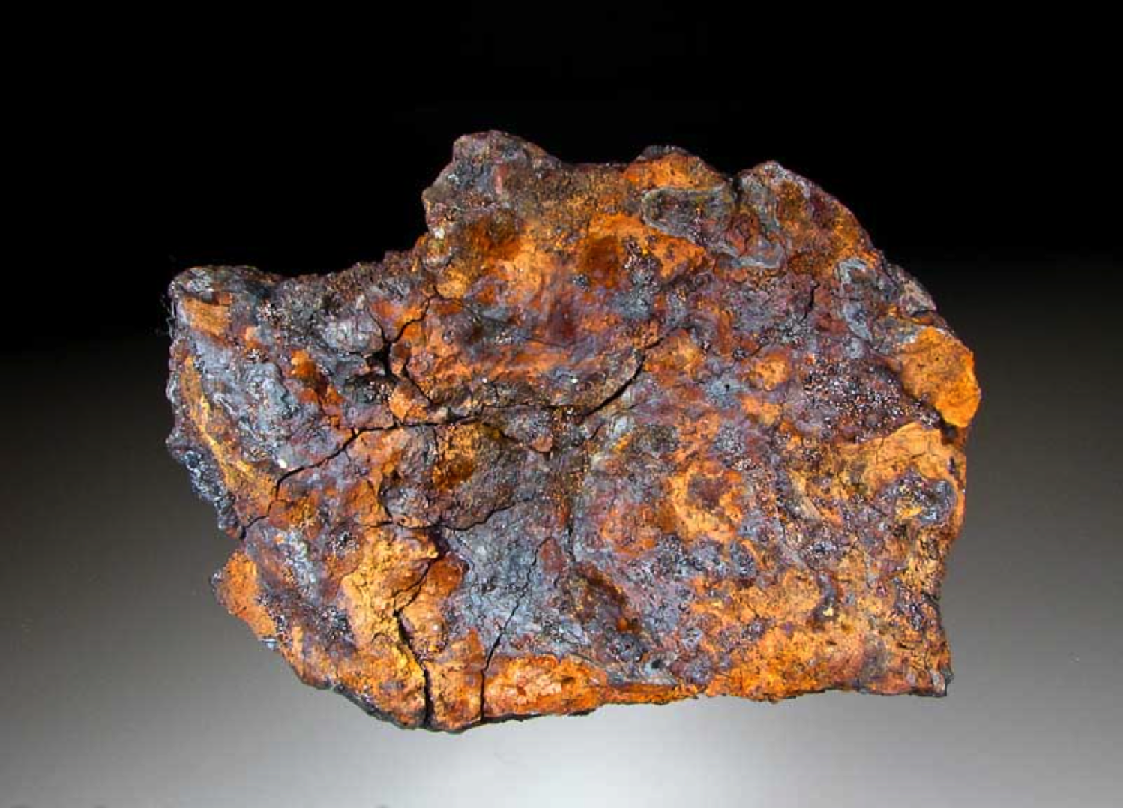
Iron
The chemical element iron is the fourth most common element in the Earth’s crust and the second most abundant metal. (3) On the Earth iron occurs mainly in iron-oxide ores. One of these ores is lodestone, or magnetite, named for its property of magnetism. Hematite is the most plentiful ore, but it contains less iron than magnetite. Limonite and siderite are less abundant ores of iron. Iron, alloyed with nickel, is also found in meteorites. (11) Iron was used by early people. Its chemical symbol, Fe, is taken from the Latin ferrum. The name iron is from the Anglo-Saxon iren or isern. About 5 percent of the Earth’s crust is composed of iron. The metal is chemically active and is found in nature combined with other elements in rocks and soils. Both plants and animals also contain very small amounts of iron. (11) It is a metal whose hardness and malleability made it ideal for implements of war and agricultural tools. (3)
Description
Iron is a malleable metal derived from common oxide ores such as hematite and limonite. It is the primary ingredient in wrought iron and steel. The working and use of iron are evidenced artifactually in the early 3rd-millennium B.C. These early artifacts are typically high in nickel content and are apparently made of meteoric iron. The celestial origins of early iron are indicated in Old Kingdom Egyptian references to it as the “metal of heaven” and in the Sumerian cuneiform signs for “sky” and “fire” used to designate the metal in Mesopotamia. Artifacts were made of terrestrial iron in Anatolia by the middle of the 3rd millennium. Iron technology was greatly advanced by the Hittites in the 2nd millennium. Currently, the earliest physical evidence of iron mining and smelting in Canaan is from the end of the 2nd millennium at Timnah. In the 1st millennium iron became the chief utilitarian metal in the Levant, hence the designation of the period as the Iron Age. (6)
By the beginning of the 1st millennium, iron supplanted bronze as the standard utilitarian metal for most all metal items with the exception of those which were cast with intricate details and those in which aesthetics required a material other than iron. Economic factors contributed to this transition. Iron production utilized locally available ores and eliminated the need for expensive tin imports. A further advantage in iron production was that the process required only half the amount of fuel needed for bronze. The only disadvantage of ironworking was that it was more labor-intensive, but this was no great obstacle since labor was cheap. (6)
In the Bible, the eponymous “father of metallurgists,” Tubal-Cain, is recognized as the forebear of those who worked in bronze and iron. (6) As iron is generally found in combination with oxygen, the working or forging of it by Tubal-Cain implies knowledge of smelting. (15)
Now Zillah also gave birth to Tubal-Cain, who heated metal and shaped all kinds of tools made of bronze and iron. The sister of Tubal-Cain was Naamah. (Genesis 4:22 NET)
Some scholars have often taken exception to the mention of iron in certain parts of the Pentateuch (i.e., Genesis, Exodus, Leviticus, Numbers, and Deuteronomy). However, the finds of iron objects in the ancient Near East from prehistoric and historic times provide conclusive archeological evidence that iron was known and used long before the time of Moses, and that statements in the Pentateuch about the early use of iron are in harmony with known facts. (5)
Similar workers of iron are referred to in the reigns of David (2 Chronicles 2:7, 14) and Joash (2 Chronicles 24:1-14). (13a)
According to the biblical text, iron was well known in the time of Moses. In the context of the Exodus, Canaan was recognized as a place where the Israelites could exploit local iron ores. (6)
For the LORD your God is bringing you to a good land, a land of brooks, springs, and fountains flowing forth in valleys and hills, a land of wheat, barley, vines, fig trees, and pomegranates, of olive trees and honey, a land where you may eat food in plenty and find no lack of anything, a land whose stones are iron and from whose hills you can mine copper. You will eat your fill and then praise the LORD your God because of the good land he has given you. (Deuteronomy 8:7–10 NET)
Iron tools were in use as they were forbidden from being used on the altar stones. (6)
Then you must build an altar there to the LORD your God, an altar of stones—do not use an iron tool on them. (Deuteronomy 27:5 NET)
They were forbidden from using iron tools to commit murder: (6)
“But if he hits someone with an iron tool so that he dies, he is a murderer. The murderer must surely be put to death. (Numbers 35:16 NET)
Iron is not mentioned as being employed in the manufacture of the tabernacle, but its manufacturing process was known well enough to form a figure of speech to describe the cultural experience of the Israelites in Egypt. (6) Captivity in Egypt is likened to being in an iron furnace (Deuteronomy 4:20) (3). In the Conquest and until the Davidic monarchy, the Israelites appear to have been at a metallurgical disadvantage to the Canaanites, whose “iron chariots” were a powerful deterrent to Israelite expansion into the plains (Joshua 17:16; Judges 1:19;4:3). Subsequently, the Philistines, who used iron weapons like those found in 11th-century contexts at their cities of Ekron and Tell Qasile, maintained a monopoly on metallurgy and iron in particular, which helped them to dominate the Israelites (1 Samuel 13:19–22). The metallurgical monopoly was broken by King David, who infiltrated the Philistines. He forced subject Ammonites to work for him using iron implements such as saws, picks, and axes (2 Samuel. 12:31). Iron came to be widely utilized in architecture (Jeremiah. 1:18), particularly with iron bars and nails strengthening doors (1 Chronicles 22:3; Isaiah 45:2). Iron tools were widely used by the Hebrews (1 Chronicles 20:3) and were of considerable value (1 Chronicles 29:7). In taxonomic lists, iron is listed behind gold, silver, and bronze (Joshua 6:19; 22:8; 2 Chronicles 2:14; Daniel 2:33–35) but ahead of lead (Ezekiel 22:20). Iron is symbolic of strength in both the Old and New Covenants (e.g., Job 40:18; Revelation 12:5). (6)
Iron is mentioned among the spoils carried home by the tribe of Manasseh after the conquest of Canaan (Joshua 22:8). (13a) It is mentioned in Numbers 31:22 in a list of incombustible materials taken as booty in the defeat of Midian that was required to be purified (Numbers 31:22). (3)(13a)
Physical and Chemical Properties
This well-known metal is one of the so-called elementary substances. From its abundance, the ease with which it can be separated from its ores, and its many useful properties, it is the most important of all the metals. Ordinary iron is not a pure element, but always contains a small amount of carbon, the proportion of which greatly affects its qualities. Native iron is almost unknown except in meteorites. Meteoric iron, however, contains impurities that make it brittle and exceedingly difficult to forge. (13a)
The utilization of iron supplanted bronze as a result of technological advances, the properties of the metal, and economic factors. The development of iron was initially limited by pyro technology. Ancient furnaces which could melt copper from cuprous ores at 1083°C (1981.4°F) were not hot enough to melt iron from ferrous ores at 1538°C (2800°F). With a draft from blowpipes and bellows, sufficient heat could be generated to melt away impurities and to create spongelike “Iron blooms” of about 10 kg. (22 lb.) which had to be reheated and hammered to knock away impurities of slag and charcoal, and to make wrought iron. The iron product produced in this manner was not as tough as hardened bronze and could not be cast in molds, since it was not liquified. The use of charcoal in shaft furnaces which created a reducing atmosphere of carbon monoxide made it possible to efficiently separate iron from its oxide and carbonate ores. (6) Although the scientific basis for this—that the furnace charcoal added carbon to the iron and reheating removed a material which made the iron brittle—was unknown until modern times, a manufacturing method had been found which paved the way for the widespread use of iron. (7)
In modern processes, iron is separated from its ores in the form of cast iron, from which the other forms are obtained by removing some of the carbon. The high temperature required to melt cast iron has been urged as a difficulty in the way of understanding the use of the metal in early times. But iron can be separated from its ores without being melted. In many countries, primitive processes of iron manufacture survive and are carried on to the present day. These doubtless represent the ancient methods, and again their crude product is not cast iron, but a ‘bloom’ or spongy mass of wrought iron or steel. (13a)
When the quantity of carbon is small (from 0.15 to 0.5 percent) we have wrought iron, which is extremely difficult to melt, but is tough, and can be welded at white heat. When the percentage of carbon is from 3 to 6 we have cast iron, which is brittle and cannot be welded, but which can be melted and cast in a mold. The intermediate variety contains from 0.6 to 2 percent. of carbon, is steel, which can be both cast and welded, and can also be tempered to various degrees of elasticity and hardness. (13a) This steel, when heated white-hot and rapidly cooled by quenching, produced a tempered product that could attain a hardness of 6.5 on the Mohs’ scale, surpassing the best bronze (3.5 on the Mohs’ scale) and having a much higher tensile strength and shock resistance. Ferrous metals thus could provide working edges on tools and weapons that could withstand intensive wear. (6)

Pig-iron is a mere play upon the word sow. When iron is melted it runs off into a channel called a sow, the lateral branches of which are called the pigs; there the iron cools and is called pig-iron. (14)
Iron, like other metals, conducts heat and electricity, has a luster, and forms positive ions in its chemical reactions. Pure iron is fairly soft and can easily be shaped and formed when hot. Its color is silvery white. Iron is easily magnetized. Again, when combined with small amounts of carbon, it becomes steel. The crystal structure and magnetism of iron undergo changes when it is heated. If an iron magnet is heated red hot, it loses its magnetism but regains it when it is cooled. In the presence of moisture, iron rusts quickly because it combines easily with oxygen in the air. Iron can be protected against rusting by coating it with a phosphate solution. Coating iron with zinc to make galvanized iron also prevents rusting. (11)
An oxide of iron, Venetian red, is used as a pigment in the paint for bridges and railroad cars and in rouge for cosmetics and for polishing lenses.
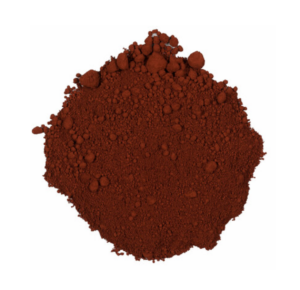
Laundry bluing and the blueprints used by architects and engineers contain the pigment called Prussian blue, which is an iron compound. Iron cores are used in electromagnets for telephones, motors, and other equipment. (11)
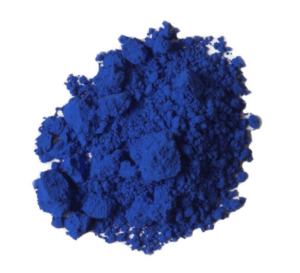
Production
The thirteenth-century saw the irruption of the Sea Peoples (i.e., the Philistines) from Asia Minor into the eastern Mediterranean. A variety of ethnic groups, vigorous and militarily adept, were pushed into Canaan by land and sea. One result was the disruption of traditional trade routes in the region, including sources of supply for bronze; another was the introduction of iron to the area by the Philistines. The land of Israel had been a part of the Egyptian Empire, and while the Egyptians were able to repulse the Sea Peoples from Egypt itself, Canaan fell into the hands of such peoples as the Israelites and Philistines. The Philistines dominated the seacoast and occupied strategic points on the plain of Esdraelon and the Jordan valley, and friction between them and the Israelites was inevitable (1 Sam. 13:19–22). Iron weapons, war chariots, and a centralized organization made the Philistines and their allies (cf. Judges 4:3) a constant threat to the Israelites which was not eliminated until David became king. (7)
Iron soon became popular for use in sword blades, spearpoints (1 Samuel 17:7), and arrowheads, but it also came to be used for tools and farm implements (2 Samuel 12:31; Job 19:24; Jeremiah 17:1; Amos 1:3).
King Og of Bashan had a bed made of iron (Deuteronomy 3:11). (7) The iron for this “bedstead” (ʿereś) may have come from the rich iron ores and smelting area of Mugharet el-Wardeh. The entire bed may not have been of solid iron. It probably had iron fittings or trimmings like the “beds of ivory” (Amos 6:4) which were inlaid with ivory, or the bronze bed from Tell el-Fârʿah which was a bed with bronze fittings. Sometimes the word “iron” in this passage has been translated as “basalt,” and correspondingly the word for “bed” as “sarcophagus.” These suggestions lack contemporary literary support, as does the suggestion that the bed refers to a dolmen (i.e. a tomb). (5)
Vast quantities of iron were used in the construction of the Jerusalem temple. (7) King David prepared it in great abundance for the temple (1 Chronicles 22:3,14,16) (8)
David supplied a great deal of iron to make the nails for the doors of the gateways and for the fittings, together with an immeasurable quantity of bronze, (1 Chronicles 22:3 NET)
However, it was only used on the nails for the temple doors of the gates and for clamps, as iron was prohibited within the temple (1 Kings 6:7). Later rabbinic interpreters gave the reason: It is not right to use instruments of death in the creation of an instrument of life. (9) In addition, various members of the royal court also contributed 100,000 talents of iron (about 3,450 metric tons) to the service of the temple (1 Chronicles 29:7). (7)
History
The importance of iron in antiquity is attested by its use in pre-Iron Age periods. Meteoric iron, known by the name ‘metal of heaven’ in Egyptian texts, was used for ornaments, jewelry, and dagger blades as early as 2000 b.c. The beginnings of iron metallurgy (smelting and forging) are linked generally to the Hittites of Asia Minor, ca. 1400 b.c. The Iron Age in Canaan is separated into three time periods:
- Iron I (1200-1000 b.c., biblically the era of judges and the United Monarchy);
- Iron II (1000-586 b.c., Divided Monarchy); and
- Iron III (or Persian, ca. 587-332 b.c., the Exile and Restoration). (9)
The history of smelting technology informs the images of metals in Scripture. While the text offers only a glimpse at ritual vestiges of the shift from stone to copper and bronze tools (Exodus 4:25; Joshua 5:2; cf. Genesis 4:22), the transition from bronze to iron provides the backdrop for the Israelite struggle for independence from oppressive neighbors cunningly maintaining a monopoly on iron forging technology through treaties with clans of smiths (Judges 4:17; cf. Genesis 4:22). (2)
A durable iron weapon held its edge while instantly blunting or even breaking a bronze sword. The superiority of iron weapons repeatedly placed the Israelites at a distinct military disadvantage. Even their agricultural tools required costly Philistine maintenance (1 Sam 13:20–21). When Israel first entered the land, they were dependent upon the Canaanites for iron working (1 Sam 13:19–22). For reasons both economic and mystical, the Philistine-controlled craftsmen carefully guarded their trade secrets so that not a blacksmith could be found in the whole land of Israel depriving them of swords and spears!
A blacksmith could not be found in all the land of Israel, for the Philistines had said, “This will prevent the Hebrews from making swords and spears.” So all Israel had to go down to the Philistines in order to get their plowshares, cutting instruments, axes, and sickles sharpened. They charged two-thirds of a shekel to sharpen plowshares and cutting instruments, and a third of a shekel to sharpen picks and axes, and to set ox goads. So on the day of the battle no sword or spear was to be found in the hand of anyone in the army that was with Saul and Jonathan. No one but Saul and his son Jonathan had them. (1 Samuel 13:19–22 NET)
The song of Deborah describes the tribes as unarmed peasants (Judges 5:7–8).
Warriors were scarce, they were scarce in Israel, until you arose, Deborah, until you arose as a motherly protector in Israel. God chose new leaders, then fighters appeared in the city gates; but, I swear, not a shield or spear could be found, among forty military units in Israel. (Judges 5:7–8 NET)

Again, the Philistines prevented Israel from manufacturing iron weapons and tools in order to protect their own monopoly on iron and made Israel dependent on Philistine ironsmiths for all services (1 Samuel 13:19–22). Iron was still not plentiful in Israel at that time. (5)
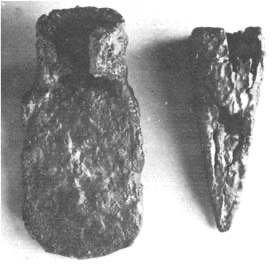
Iron hoe (left) and plowshare, 10th cent. b.c., found at Tell Jemmeh, 10 km (6 mi) S of Gaza (Israel Department of Antiquities and Museums) (5)
The military successes of David rest in part on the increased availability of iron tools (2 Samuel 12:31). The obscure foreign origins of barzel, the Hebrew word for iron, suggest that the term was borrowed along with the technology. (2)
Typological Meanings
Iron occurs symbolically with several connotations.
As the hardest metal known at that time, it carried an aura of the highest level of technological innovation. Even though the production of iron eventually spread quite widely, several requirements retarded this spread: access to jealously guarded secrets, sources of ore, a knowledge base and a significant level of skill. The smiths carefully shielded their secrets from all outside their clan. The mystery and magic surrounding smelting, and especially the higher temperatures and quality controls necessary for iron production, made smiths the wizards and high priests of technology and an essential element in any plans for independence or military expansion.
Job cites the hiding of iron in the earth as an example of divine, inscrutable wisdom (Job 28:2). Playing on the mystique of iron, Jeremiah mentions that the “sin of Judah” is written with an iron stylus (Jeremiah 17:1), suggesting that the very hardness of his writing tool (he compares it to a diamond stylus) also implies a permanence of what is written (cf. Job 19:24). (2)
The terror of the iron chariots (Joshua 17:6;17:18; Judges 1:9;4:3;4:13) comes in part from their actual effectiveness and in part from incorporating the symbolic technological advantage of invincible components, an advantage denied Israel for a time.
The mystery of iron working, the irony that a flat iron hammer should pound out a sharp edge, provides the setting for the proverb:
As iron sharpens iron, so a person sharpens his friend. (Proverbs 27:17 NET)
Meaning that accountability to a peer and tough-minded interaction produce a razor-sharp mind and keenness of character. (2)
Iron symbolizes great power and persistence. Behemoth owes his strength to “limbs like bars of iron” (Job 40:18), and Leviathan’s mythical strength “counts iron as straw” (Job 41:27). To be put in irons makes escape impossible (Psalms 107:10). The “iron pillar” (Jeremiah 1:18) symbolizes unconquerable strength and prophetic boldness while the “necks of iron” represent an unrepentant persistence that will not be broken (Isaiah 48:4). (2) Bronze and iron as compared with gold and silver refer to Israel’s corruption (Jeremiah 6:28; cf. Ezekiel 22:18), iron being an impurity in silver. (5)(13a) In a similar vein an unrelenting drought and infertility is symbolized as a bronze sky and an iron earth. In this, Moses uses iron in a simile, stressing its hard and unyielding property (Leviticus 26:19)(Deuteronomy 28:23)(2)(3). Moses threatens the disobedient with a “yoke of iron” (Deuteronomy 28:48). (3) The strength of life is like bolts of iron and bronze (Deuteronomy 33:25). The stump and roots of a tree are as strong as iron and bronze fetters (Daniel 4:15, 23). (2)(5)
In Nebuchadnezzar’s dream the relative value of metals plays an important role in Daniel’s description of the four world empires (Daniel 2:41). (1) The comparative valuation of metals plays an important role in the symbolism of the world empires of Daniel 2:
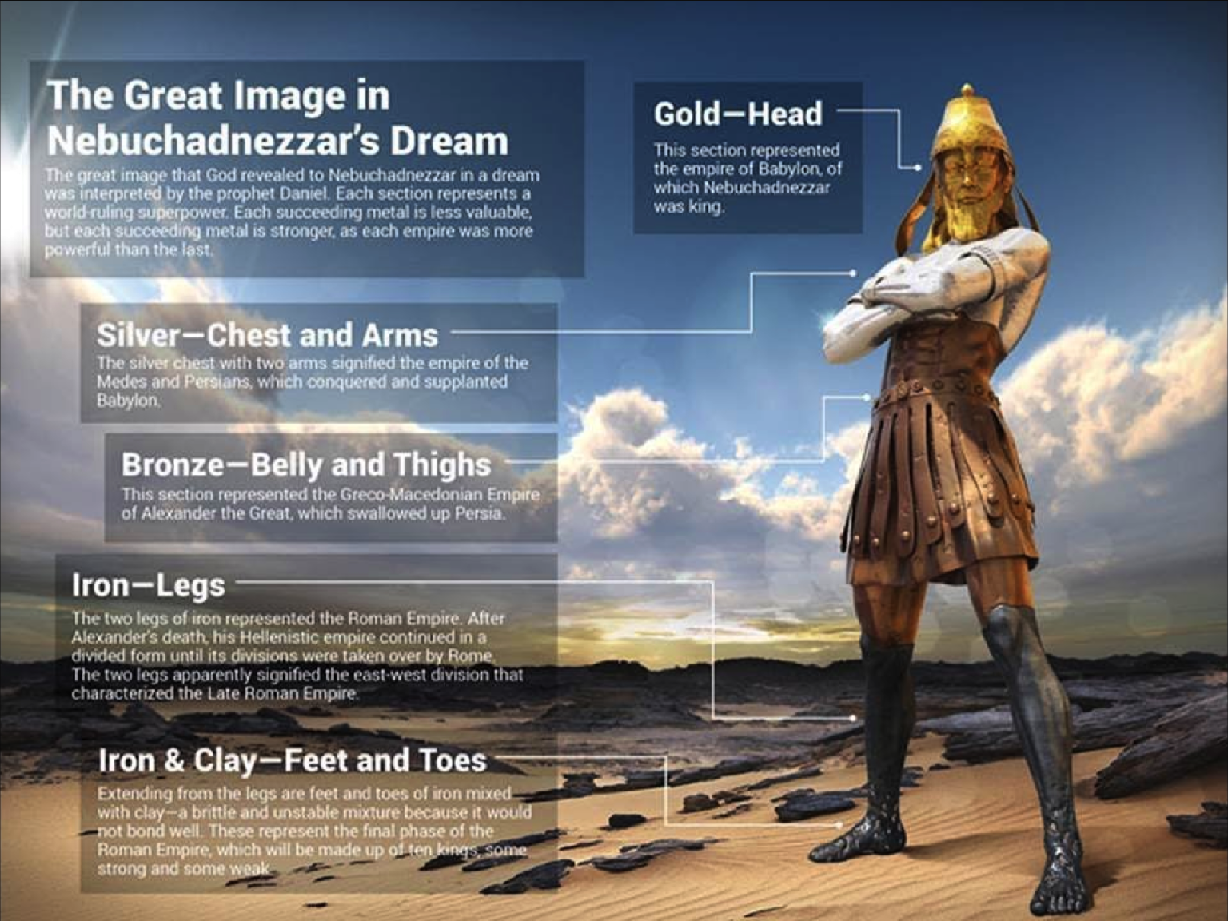
- Gold (1) = Babylon,
- Silver (1) = Medo-Persia,
- Bronze (1) = Greece,
- Iron Legs = Rome, and
- Iron & Clay (1) = Revived Rome in the last days.
Iron is the least valued metal in this scale. (5) Though inferior in value as compared with the other metals, iron is superior in strength. In Daniel’s vision the “teeth of iron” are unbreakable and represent unrelenting cruelty (Daniel 7:7,19) (2) These powerful iron teeth of the fourth beast symbolize the same power that is portrayed by the iron legs of Daniel 2:40, speaking of the superior strength and intense power of destruction of this beast as it devours and subdues other nations. From these examples it is apparent that iron is a symbol of unsubdued power, unusual force, and firm persistence while it is at the same time inferior in value to gold, silver, and bronze on the symbolic scale. (5) Again, while iron is the least-valued metal in this ranking, it is superior in strength, hinting at a government lacking in religious values or cultural achievement, but ruling with an unbending will. Similarly, the prophet Amos alludes to the unmerciful savagery of war as “threshing sledges with iron teeth” (Amos 1:3). (2)
Related to the hardness of iron, it is used as a threat of judgment (Psalms 2:9; Revelation 2:27). (4) The furnace of iron (Deuteronomy. 4:20; 1 Kings 8:51; Jeremiah 11:4; Ezekiel 22:18) is a figure which vividly expresses hard bondage as represented by the severe labor attendant upon the operation of smelting. (15) The cauterizing effect of hot iron was used by Paul to describe those with no conscience. (4)
Now the Spirit explicitly says that in the later times some will desert the faith and occupy themselves with deceiving spirits and demonic teachings, influenced by the hypocrisy of liars whose consciences are seared. They will prohibit marriage and require abstinence from foods that God created to be received with thanksgiving by those who believe and know the truth. For every creation of God is good and no food is to be rejected if it is received with thanksgiving. For it is sanctified by God’s word and by prayer. (1 Timothy 4:1–5 NET)
Prophetic references to iron include the most descriptive passages of the ironsmith’s craft (Isaiah 44:12; 54:16) as well as the metaphoric use of iron as a symbol of strength and toughness (Isaiah 48:4; Daniel 2:40; Jeremiah 1:18); servitude (Jeremiah 28:13–14; see also Deuteronomy 4:20); and judgment (Isaiah 1:25; Jeremiah 6:29–30; Ezekiel 22:20–31). In Psalms, Proverbs, and Daniel, iron is referred to in historical allusion (Psalms 105:18 tells that Joseph’s neck was put in an iron collar when he was sold as a slave). (3)
The New Covenant mentions iron once in Acts and five times in the Revelation to John. These references describe objects made of iron (e.g., an iron gate (Acts 12:10), a rod of iron (Revelation 2:27;12:5;19:15), breastplates of iron (Revelation 9:9), and other items made of iron (Revelation 18:12). (3)

Scepter of Iron
A scepter (Hebrew shebet; Greek skeptron) is simply a staff or rod that is a symbol of rule and authority, such as denoted in Isaiah. (17)
The LORD has broken the staff of the wicked, the scepter of the rulers. (Isaiah 14:5 NET)
The scepter was a wooden staff or wand, 5 or 6 feet long, usually overlaid with gold or decorated with golden rings, with an ornamented point. It was borne in the hands of kings and others in authority as a token of power. When the scepter was held out to be touched by an individual approaching the throne, it was a sign of the royal acceptance and favor. (cf. Esther 8:4)(18)
The symbol of the scepter derived from the thought that a ruler was the shepherd (1) of his people, and so at times, a scepter was also used as a symbol for a ruler or shepherd. (17) The scepter became a Messianic symbol linked with prophecies about a future ruler of Israel.
Judah is a young lion — my son, you return from the kill. He crouches; he lies down like a lion or a lioness—who dares to rouse him? The scepter will not depart from Judah or the staff from between his feet until He whose right it is comes and the obedience of the peoples belongs to Him. He ties his donkey to a vine, and the colt of his donkey to the choice vine. He washes his clothes in wine and his robes in the blood of grapes. His eyes are darker than wine, and his teeth are whiter than milk. (Genesis 49:8–12 NET)
I see him, but not now; I perceive him, but not near. A star (cf. Revelation 2:28) will come from Jacob, and a scepter will arise from Israel. He will smash the forehead of Moab and strike down all the Shethites. Edom will become a possession; Seir will become a possession of its enemies, but Israel will be triumphant. One who comes from Jacob will rule; he will destroy the city’s survivors. (Numbers 24:17–19 NET)
Your throne, God, is forever and ever; the scepter of Your kingdom is a scepter of justice. You love righteousness and hate wickedness; therefore God, your God, has anointed you with the oil of joy more than your companions. (Psalm 45:6–7 NET)
So the woman gave birth to a son, a male child, who is going to rule over all the nations with an iron rod. (1) Her child was suddenly caught up to God and to his throne, (Revelation 12:5 NET)
From his mouth extends a sharp sword, so that with it he can strike the nations. He will rule them with an iron rod, and he stomps the winepress of the furious wrath of God, the All-Powerful. He has a name written on his clothing and on his thigh: “King of kings and Lord of lords.” (Revelation 19:15–16 NET)
There is no biblical (or in ancient writings (17)) instance of a “scepter being actually handled by a Jewish king. The term is used metaphorically. The use of a staff as a symbol of authority was not confined to kings: it might be used by any leader.”—Smith. (18)
Jesus promises those who overcome the threat of false teaching in the church (1) will share with him in his reign over the nations (Revelation 2:26); they are not only a kingdom and priests (Revelation 1:6; 5:10) but those who will reign with him (Revelation 5:10), both during the thousand years (Revelation 20:6) and eternally (Revelation 22:5). (19)
And to the one who conquers and who continues in my deeds until the end, I will give him authority over the nations— he will rule them with an iron rod and like clay jars he will break them to pieces, (Revelation 2:26–27 NET)
The one who is victorious and keeps My works to the end: I will give him authority over the nations— and he will shepherd them with an iron scepter; he will shatter them like pottery — just as I have received this from My Father. (Revelation 2:26–27 HCSB)
They will share in Jesus’ rule with an iron rod (or scepter (20)) (Revelation 2:27), a hope derived from the messianic promise of Psalm 2. (19)
The king says, “I will announce the Lord’s decree. He said to me: ‘You are my son! This very day I have become your father! Ask me, and I will give you the nations as your inheritance, the ends of the earth as your personal property. You will break them with an iron scepter; you will smash them like a potter’s jar!’ ” So now, you kings, do what is wise; you rulers of the earth, submit to correction! Serve the Lord in fear! Repent in terror! Give sincere homage! Otherwise he will be angry, and you will die because of your behavior, when his anger quickly ignites. How blessed are all who take shelter in him! (Psalm 2:7–12 NET)
The rod or scepter of iron symbolizes:
- someone ruling “with a rod of iron” (Revelation 2:27; 12:5; 19:15). (3)
- a harsh or unyielding reign (Psalms 2:9; Revelation 2:27;12:5;19:15). (2)
- a stern government (Psalms 2:9)(8)
- severity (Psalms 2:9) (10)
- a rule of irresistible might. (13a)
Like the most popular Greek version of the Old Testament, Revelation speaks not merely of “ruling” the nations with an iron rod but of “shepherding” them, emphasizing again that they will share Jesus’ authority (Revelation 7:17). (19) Although Psalm 2 addressed God’s messianic viceroy alone, Jesus shares his rule with his people, for God has delegated rule over the earth to humanity (Genesis 1:26–27; Psalms 8:6; cf. Daniel 7:14, 22). (19)
The frequency of the message of Yeshua “giving” in the Greek text of these letters to the churches of Revelation underlines the promises to the overcomer (Revelations 2:7, 10, 17, 26, 28; 3:9, 21). (19)
The overcomer (1) will:
- Eat from the tree of life.
- Not be hurt by the second death.
- Eat the hidden manna of the life of God.
- Receive a white stone of acceptance with a new name.
- Have power over the nations.
- Rule with the Lord with a rod of iron.
- Receive the Bright and Morning Star.
- Be clothed in white garments.
- Have their names written in the Book of Life.
- Hear the Lord confess their names as His own before His Father and the angels.
- Be a pillar in the Temple of God.
- Receive a new name to manifest the glory of God forever.
- Sit with Messiah on His throne.
Jesus will also give those who overcome the morning star (Revelation 2:28). Ancients emphasized the glory of the planet Venus, the “morning star,” and could apply the image to magnificent rulers (Isaiah 14:12). Romans associated Venus with triumph and reign, hence praising this goddess for their conquests. In Revelation, Jesus is himself the morning star (Revelation 22:16), probably alluding to the promised star of Numbers 24:17, which many ancient Jews understood messianically. (19)
In other words, Jesus’ promise to the church in Thyatira (1) suggests that he will share not only victory in an abstract sense (2:26) but himself as the morning star with his people (Revelation 2:28). He is greater than the stars, who are angels of the churches (Revelations 1:20). (19)
Sing to the LORD a new song! Sing to the LORD, all the earth! Sing to the LORD! Praise his name! Announce every day how he delivers! Tell the nations about his splendor! Tell all the nations about his amazing deeds! For the LORD is great and certainly worthy of praise; he is more awesome than all gods. For all the gods of the nations are worthless, but the LORD made the sky. Majestic splendor emanates from him; his sanctuary is firmly established and beautiful. Ascribe to the LORD, O families of the nations, ascribe to the LORD splendor and strength! Ascribe to the LORD the splendor he deserves! Bring an offering and enter his courts! Worship the LORD in holy attire! Tremble before him, all the earth! Say among the nations, “The LORD reigns! The world is established, it cannot be moved. He judges the nations fairly.” Let the sky rejoice, and the earth be happy! Let the sea and everything in it shout! Let the fields and everything in them celebrate! Then let the trees of the forest shout with joy before the LORD, for he comes! For he comes to judge the earth! He judges the world fairly, and the nations in accordance with his justice. (Psalm 96:1–13 NET)
Sing to the LORD a new song, for he performs amazing deeds! His right hand and his mighty arm accomplish deliverance. The LORD demonstrates his power to deliver; in the sight of the nations he reveals his justice. He remains loyal and faithful to the family of Israel. All the ends of the earth see our God deliver us. Shout out praises to the LORD, all the earth! Break out in a joyful shout and sing! Sing to the LORD accompanied by a harp, accompanied by a harp and the sound of music! With trumpets and the blaring of the ram’s horn, shout out praises before the king, the LORD! Let the sea and everything in it shout, along with the world and those who live in it! Let the rivers clap their hands! Let the mountains sing in unison before the LORD! For he comes to judge the earth! He judges the world fairly, and the nations in a just manner. (Psalm 98:1–9 NET)
The God who made the world and everything in it, who is Lord of heaven and earth, does not live in temples made by human hands, nor is he served by human hands, as if he needed anything, because he himself gives life and breath and everything to everyone. From one man he made every nation of the human race to inhabit the entire earth, determining their set times and the fixed limits of the places where they would live, so that they would search for God and perhaps grope around for him and find him, though he is not far from each one of us. For in him we live and move about and exist, as even some of your own poets have said, ‘For we too are his offspring.’So since we are God’s offspring, we should not think the deity is like gold or silver or stone, an image made by human skill and imagination. Therefore, although God has overlooked such times of ignorance, he now commands all people everywhere to repent, because he has set a day on which he is going to judge the world in righteousness, by a man whom he designated, having provided proof to everyone by raising him from the dead.” (Acts 17:24–31 NET)
The reward which the righteous receive is life; the recompense which the wicked receive is judgment. (Proverbs 10:16 NET)
Biblical Typologies, Metaphors, & Similes Series:
- The Old Leaven of the Kingdom of Darkness
- The New Leaven of the Kingdom of Heaven
- Wine
- Water
- Finely Sifted (Wheat) Flour
- Frankincense
- Myrrh
- Anointing Oil
- Olive Oil
- Honey
- Salt
- Waving and Heaving
- Barley
- Gold
- Silver
- Bronze
- Stone
- Wood
- Linen
- Iron
- Shofar and Trumpet
Shalom
(Security, Wholeness, Success)
Peace
Then he said to them, “Therefore every expert in the law who has been trained for the kingdom of heaven is like the owner of a house who brings out of his treasure what is new and old.” (Matthew 13:52 NET)
(1) Select the link to open another article with additional information in a new tab.
(2) Leland Ryken et al., Dictionary of Biblical Imagery (Downers Grove, IL: InterVarsity Press, 2000), 426–427.
(3) Robert A. Coughenour, “Iron,” ed. Mark Allan Powell, The HarperCollins Bible Dictionary (Revised and Updated) (New York: HarperCollins, 2011), 408–409.
Wertime, T. A., and J. D. Muhly, eds. The Coming of the Iron Age. Yale University Press, 1980.
(4) Tim Turnham, “Iron,” ed. Chad Brand et al., Holman Illustrated Bible Dictionary (Nashville, TN: Holman Bible Publishers, 2003), 834–835.
(5) G. F. Hasel, “Iron,” ed. Geoffrey W Bromiley, The International Standard Bible Encyclopedia, Revised (Wm. B. Eerdmans, 1979–1988), 880–882.
A. C. Richardson, American Journal of Archaeology, 38 (1934), 555–583; V. G. Childe, New Light on the Most Ancient East (1935); G. A. Wainwright, Antiquity, 10 (1936), 5–24; W. Witter, Forschungen und Fortschritte, 17 (1941), 223–25; A. Lucas, Ancient Egyptian Materials and Industries (3rd ed 1948); W. F. Albright, BASOR, 120 (1950), 22–25; AP; O. Johannsen, Geschichte des Eisens (3rd ed 1953); R. North, Orientalia, 24 (1955), 78–88; H. Maryon, American Journal of Archaeology, 65 (1961), 173–184; IDB, II, s.v. “Iron” (F. V. Winnett); RAC, VI, s.v. “Erz” (Hill, Mundle); WBA; R. J. Forbes, Studies in Ancient Technology, IX (1964), 175–290; O. R. Gurney, Hittites (rev ed 1966).
(6) Robert W. Smith, “Iron,” ed. David Noel Freedman, Allen C. Myers, and Astrid B. Beck, Eerdmans Dictionary of the Bible (Grand Rapids, MI: W.B. Eerdmans, 2000), 645–646.
V. C. Pigott, “Near Eastern Archaeometallurgy,” in The Study of the Ancient Near East in the Twenty-first Century, ed. J. S. Cooper and G. M. Schwartz (Winona Lake, 1996), 139–76.
(7) Allen C. Myers, The Eerdmans Bible Dictionary (Grand Rapids, MI: Eerdmans, 1987), 528–529.
(8) M. G. Easton, Illustrated Bible Dictionary and Treasury of Biblical History, Biography, Geography, Doctrine, and Literature (New York: Harper & Brothers, 1893), 346.
(9) Paul J. Achtemeier, Harper & Row and Society of Biblical Literature, Harper’s Bible Dictionary (San Francisco: Harper & Row, 1985), 423–424.
Coughenour, R. A. ‘Preliminary Report on Mugharat Wardeh.’ Annual of the Department of Antiquities of Jordan (1976): 71-77.
Muhly, J. D. ‘How Iron Technology Changed the Ancient World.’ Biblical Archaeology Review (Nov.-Dec. 1982): 42-54.
Wertime, T. A., and J. D. Muhly, eds. The Coming of the Iron Age. New Haven, CT: Yale University Press, 1980.
(10) James A. Patch, “Iron,” ed. James Orr et al., The International Standard Bible Encyclopaedia (Chicago: The Howard-Severance Company, 1915), 1492.
(11) “Iron,” Compton’s Encyclopedia (Chicago, IL: Compton’s Encyclopedia, 2015).
(12) James Hastings et al., Dictionary of the Bible (New York: Charles Scribner’s Sons, 1909), 619.
(13a) W. M. Flinders Petrie, “IRON,” ed. James Hastings et al., A Dictionary of the Bible: Dealing with Its Language, Literature, and Contents Including the Biblical Theology (New York; Edinburgh: Charles Scribner’s Sons; T. & T. Clark, 1911–1912), 482.
(13b) Edward Hull, “MINES, MINING,” ed. James Hastings et al., A Dictionary of the Bible: Dealing with Its Language, Literature, and Contents Including the Biblical Theology (New York; Edinburgh: Charles Scribner’s Sons; T. & T. Clark, 1911–1912), 375–376.
(14) E. Cobham Brewer, ed., Dictionary of Phrase and Fable (London; Paris; Melbourne: Cassell and Company, Limited, 1895), 977.
(15) Thomas J. Shepherd, The Westminster Bible Dictionary (Philadelphia: Presbyterian Board of Publication, 1880), 260.
(16) Philip Schaff, ed., A Dictionary of the Bible: Including Biography, Natural History, Geography, Topography, Archæology, and Literature (Philadelphia; New York; Chicago: American Sunday-School Union, 1880), 404.
(17) James M. Freeman and Harold J. Chadwick, Manners & Customs of the Bible (North Brunswick, NJ: Bridge-Logos Publishers, 1998), 90.
(18) Philip Schaff, ed., A Dictionary of the Bible: Including Biography, Natural History, Geography, Topography, Archæology, and Literature (Philadelphia; New York; Chicago: American Sunday-School Union, 1880), 769.
(19) Craig S. Keener, Revelation, The NIV Application Commentary (Grand Rapids, MI: Zondervan Publishing House, 1999), 135–136.
(20) tn Or “scepter.” The Greek term ῥάβδος (rhabdos) can mean either “rod” or “scepter.”
Biblical Studies Press, The NET Bible First Edition; Bible. English. NET Bible.; The NET Bible (Biblical Studies Press, 2005).

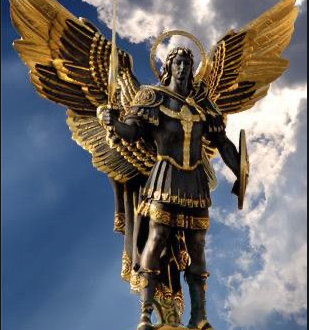


One Comment
sonshine
Hal
Long post but so informative. I loved reading about things that I never knew, like pig iron. I always heard the expression but did not know anything about it.
We just finished the book of Daniel in our Monday night online bible study. “loved” the image explaining the various metals representing the kingdoms of the world. We talked about that in our study.
Great job! Thanks for blogging with us!
Gaye